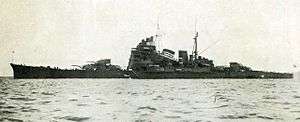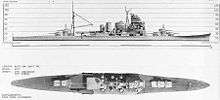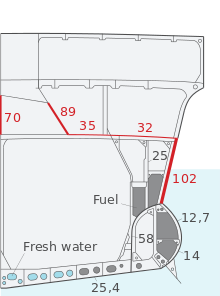Takao-class cruiser
 The cruiser Takao | |
| Class overview | |
|---|---|
| Name: | Takao class |
| Operators: |
|
| Preceded by: | Myōkō class |
| Succeeded by: | Mogami class |
| Completed: | 4 |
| Laid up: | 1 |
| Lost: | 3 |
| General characteristics | |
| Type: | Heavy cruiser |
| Displacement: |
|
| Length: |
|
| Beam: |
|
| Draft: |
|
| Propulsion: |
|
| Speed: | 35.5–34.2 knots (65.7–63.3 km/h; 40.9–39.4 mph) |
| Range: | 8,500 nautical miles (15,700 km; 9,800 mi) at 14 knots (26 km/h; 16 mph) |
| Complement: | 773 |
| Armament: |
|
| Armor: |
|
| Aircraft carried: |
|
| Aviation facilities: | 2 catapults |
The Takao-class cruiser (高雄型) was a class of four heavy cruisers of the Imperial Japanese Navy (IJN) launched between May 1930 and April 1931. They all served during World War II.
Description

The Takao class were an evolution from the preceding Myōkō class, with heavier torpedo armament and had a large, almost battleship-like bridge structure.
Their main battery was ten 20.3 cm (8 in) guns in twin mounts. They were also armed with sixteen 24 in (61 cm) torpedo tubes in four quadruple mounts.

History
The Takao-class cruisers were very versatile vessels and played a major role in many front-line battles during the Pacific War. All four ships were involved in the Battle of Midway although none saw combat, with Atago and Chōkai in Kondō's Midway invasion Force as a part of Cruiser Division 4, Section 1. Takao and Maya, as Cruiser Division 4, Section 2, were a part of the Aleutians Invasion as escorts for the Second Carrier Striking Force.[1]
Following the Midway debacle, the ships were sent to assist in the Solomons campaign. Takao, Maya and Atago spent their time primarily escorting carriers, while Chōkai played perhaps the most influential part; as flagship of Vice-Admiral Mikawa's strike force, Chōkai led the Japanese forces to victory at the Battle of Savo Island on 8 August 1942, inflicting what has been credited as the worst blue-water defeat in United States Navy history by sinking three American cruisers and severely damaging a fourth, as well as damaging the Australian cruiser Canberra to the extent that she had to be scuttled without any of the Japanese ships taking more than superficial damage, although Chōkai took the most hits.[2]
In 1943, the four ships mainly returned to Japan, where Maya was converted to an anti-aircraft cruiser. although they were redeployed to New Britain in October. On 5 November 1943, while anchored in Rabaul harbor, Maya, Takao and Atago were all damaged by aircraft from Rear-Admiral Sherman's Task Force 39, comprising the carriers Saratoga and Princeton as well as two AA cruisers and nine destroyers. Six days later, on 11 November, another strike by the same ships further damaged Maya and Atago,[3] and all three ships had to return to Japan for repairs.
In 1944, all four ships took part in the battle of the Philippine Sea, where the Fourth Cruiser Squadron escorted C Force, comprising the two superbattleships Yamato and Musashi, the two fast battleships Kongō and Haruna, three light carriers, eight heavy and one light cruiser (including the four Takao-class ships) and seven destroyers.[4] The four Takao-class ships were assigned to the same group, under Vice-Admiral Kurita, for the battle of Leyte Gulf, or Operation Sho-1 as it was known to the Japanese. The ships left Brunei on 22 October 1944 for what would be the last battle for all of them. On 23 October 1944, while passing through the Palawan Passage, the force was attacked by the submarines USS Darter and USS Dace. Darter attacked both Takao and Atago, hitting the former with three and the latter with four torpedoes. Atago was blown apart and sank rapidly, although admiral Kurita survived the sinking. Takao was critically damaged and set sail for Singapore for repairs with two destroyers, but after her arrival would never sail again. As the Atago sank, Dace blasted apart Maya with four torpedoes.[5] Chōkai, as the last surviving ship in the Fourth Cruiser Division, continued with the main force, pulling through the battle of the Sibuyan Sea unscathed. However, she was not so lucky in the action off Samar, being hit by 5in gunfire from the American escort carrier USS White Plains, which struck the decks at a great angle, penetrating down and detonating Chōkai's torpedo flask. The destroyer Fujinami took off Chōkai's crew before scuttling the ship late on 25th. Chōkai sank with around 700 survivors on board Fujinami - but their travail was not over. On 27 October, Fujinami was hit by aircraft from the carrier Essex in the Sibuyan Sea. Fujinami's magazines detonated sinking the ship with all hands on board - including every last survivor of Chōkai.[6][7]
Ships
Four ships of the class were launched. All served in World War II and all were sunk or disabled as a result of the Battle of Leyte Gulf in October 1944.
| Name | Builder | Laid | Launched | Commissioned | Fate |
|---|---|---|---|---|---|
| Takao (高雄) | Yokosuka Navy Yard | 28 Apr 1927 | 12 May 1930 | 31 May 1932 | Scuttled 27 October 1946 by British Forces |
| Atago (愛宕) | Kure Navy Yard | 28 Apr 1927 | 16 June 1930 | 30 Mar 1932 | Sunk 23 October 1944 by the submarine USS Darter. |
| Maya (摩耶) | Kōbe-Kawasaki Shipbuilding Yard | 4 Dec 1928 | 8 Nov 1930 | 30 June 1932 | Sunk 23 October 1944 by the submarine USS Dace. |
| Chōkai (鳥海) | Mitsubishi Nagasaki Shipyard | 26 Mar 1928 | 5 Apr 1931 | 30 June 1932 | Disabled 25 October 1944 at the Battle off Samar and scuttled by the destroyer Fujinami |
See also
References
- Notes
- ↑ http://www.navweaps.com/index_oob/OOB_WWII_Pacific/OOB_WWII_Midway.php
- ↑ Battle of Savo Island
- ↑ http://www.navweaps.com/index_oob/OOB_WWII_Pacific/OOB_WWII_Rabaul-Raids.php
- ↑ http://www.navweaps.com/index_oob/OOB_WWII_Pacific/OOB_WWII_Phillipine_Sea.php
- ↑ http://www.navweaps.com/index_oob/OOB_WWII_Pacific/OOB_WWII_Palawan.php
- ↑ Japanese destroyer Fujinami
- ↑ http://www.combinedfleet.com/chokai_t.htm
- Books
- D'Albas, Andrieu (1965). Death of a Navy: Japanese Naval Action in World War II. Devin-Adair Pub. ISBN 0-8159-5302-X.
- Dull, Paul S. (1978). A Battle History of the Imperial Japanese Navy, 1941-1945. Naval Institute Press. ISBN 0-87021-097-1.
- Lacroix, Eric; Linton Wells (1997). Japanese Cruisers of the Pacific War. Naval Institute Press. ISBN 0-87021-311-3.
External links
| Wikimedia Commons has media related to Takao class cruiser. |
- Parshall, Jon; Bob Hackett; Sander Kingsepp; Allyn Nevitt. "Imperial Japanese Navy Page (Combinedfleet.com)". Retrieved 2006-06-14.